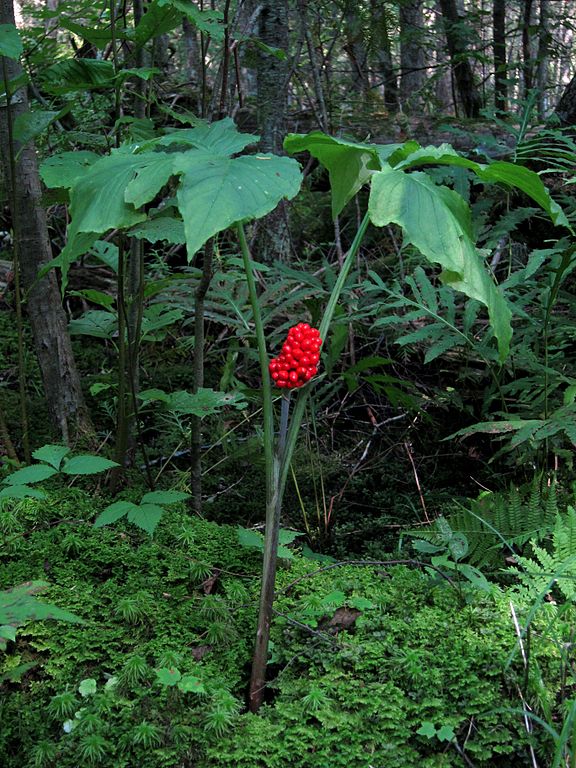Jack in the Pulpit is easily recognizable and is a unique spring ephemeral. The fleshy stalk and leaves lend an almost tropical aura to the plant. This perennial plant is about 1-2′ tall and wide. It loves part to full shade in woodland gardens and moist to wet conditions. Flowering plants initially produce only male flowers, but become hermaphroditic as they further age (male flowers on upper part of the spadix and female on lower part). The plant has light to dark green leaves. The outside of the “hood” is usually green or purple and the inside is usually striped purple/brown/greenish white, though considerable color variations exist. Most plants in a colony will become dormant and vanish by mid-summer, but the mature, flowering plant will produce a cluster of red berries which becomes visible as the spathe withers in mid to late summer.
NURSERY HOURS
Wednesday: 10-4 Thursday: 10-6 Friday-Saturday: 10-4 Sunday: 12-4
Arisaema triphyllum

Key Info
Scientific Name: Arisaema triphyllum (L.) Schott
Common Names: Jack-in-the-pulpit, Common Jack-in-the-Pulpit, Bog onion, Brown dragon, Devil's dear, Dragonroot , Indian Jack in the pulpit, Indian Turnip, Memory root, Pepper turnip, Starch wort, Three-leaved indian turnip, Wake robin, Wild turnip
Family Names: Araceae
Leaf Retention: Deciduous
Flower Color: Green, brown, purple, white or brown stripes
Additional Info
Habit: Upright, erect perennial. One to two large, glossy leaves, divided into three leaflets, rise on their own stems. The intriguing blossom of this woodland perennial occurs on a separate stalk at the same height as the leaves. It is a large, cylindrical, hooded flower, green in color with brown stripes. Distinctive "Jack-in-the-pulpit" formation grows beneath large leaves. In late summer, a cluster of bright red berries appear.
Height: 1'-2'
Spread: 1.5'
Soil Conditions: medium to wet, high organic material
Leaves: Jack-in-the-pulpit has one to two leaves, originating at the base of the stem that is divided into three almost equal leaflets. More specifically, two large green, coarse, glossy, compound, long-petioled leaves (1-1.5' long), divided into three leaflets each, emanate upward from a single stalk and provide umbrella-like shade to the flower. The light green to dark green leaflets are up to 7" long and 3" across; they are ovate or broadly rhombic, pinnately veined, glabrous, and smooth along the margins. The terminal leaflet is larger than the lateral leaflets.
Flowers (or reproductive structures: Flower structure consists of the spadix (Jack) which is an erect columnar spike containing numerous, tiny, green to purple flowers and the sheath-like spathe (pulpit) which encases the lower part of the spadix and then opens to form a hood extending over the top of the spadix. The outside of the spathe is usually green or purple and the inside is usually striped purple and greenish white, though considerable color variations exist. The flower is about 3 1/2" long and 2" across. Flowering plants initially produce only male flowers, but become hermaphroditic as they further age (male flowers on upper part of spadix and female on lower part). Pollinators crawl beneath the hooded spathe, down the spadix collecting pollen from the male flowers.
Fruit: If cross-pollination occurs, each fertilized flower will develop a fleshy, bright-red, berry-like fruit about ¼"" across; this fruit contains one or more seeds. Collectively, these fruits can form an ovoid mass up to 2"" long. Displays from June to October. Henry David Thoreau described the “arum’s” fruit as resembling “a very short thick ear of scarlet corn.” The description is very accurate! "
Natural Distribution: Woodlands, shady hillside seeps, swamp, marsh
USDA Hardiness Zone: 4 to 9
USDA Wetland Indicator Status in NC: FACW
Pollination: Fungus gnats (Sciaridae and Mycetophilidae) are believed to be the most effective pollinators. They are able to transport more pollen greater distances- essential for Arisaemas, which cannot be self-pollinated.
Wildlife Connections: Fruits eaten by Wild Turkey, Wood Thrush and eastern box turtles.
Propagation: Seeds or Cormlets can be separated from the parent corm in fall.
